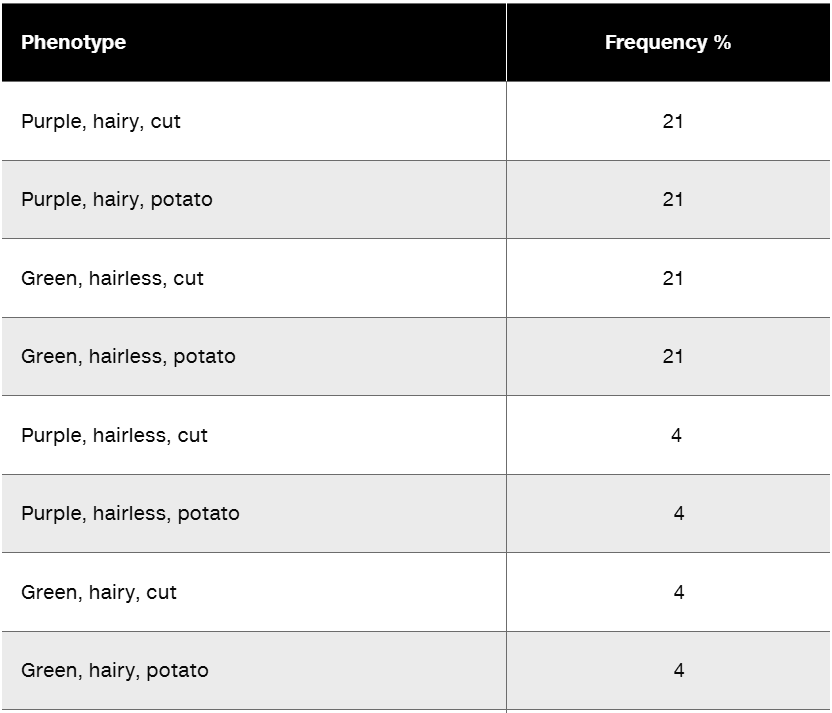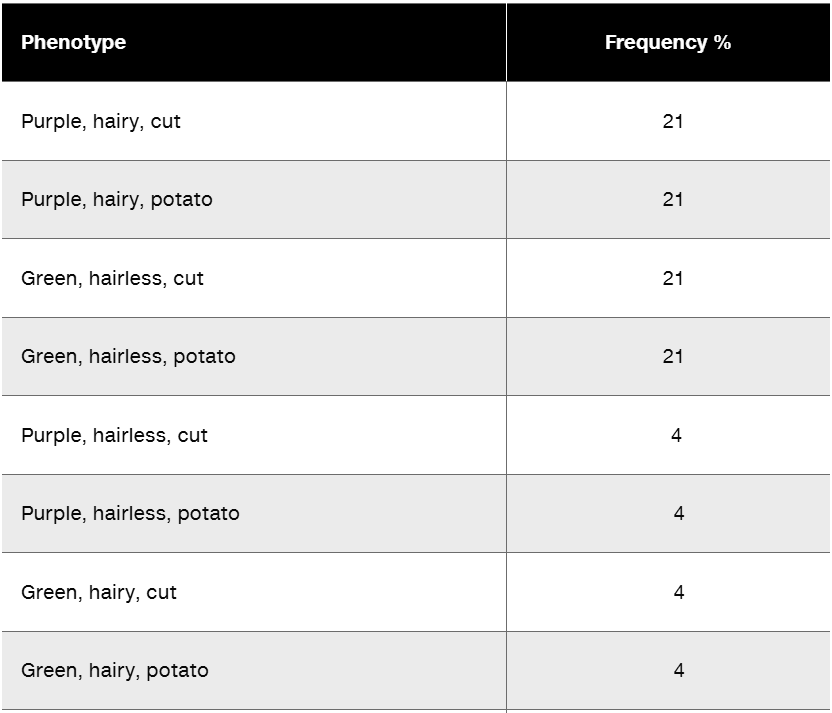 Back
BackProblem 1a
Draw a diagram illustrating the alleles on homologous chromosomes for the genotypes given, assuming in each case that the genes reside on the chromosome in the order written.
AB/ab
Problem 1b
Draw a diagram illustrating the alleles on homologous chromosomes for the genotypes given, assuming in each case that the genes reside on the chromosome in the order written.
aBc/abC
Problem 1c
Draw a diagram illustrating the alleles on homologous chromosomes for the genotypes given, assuming in each case that the genes reside on the chromosome in the order written.
DFg/DFG
Problem 1d
Give the information requested.
The gametes produced by an organism with the genotype Rt/rT
Problem 1e
Give the information requested.
Progeny of the cross Rt/rT×rt/rt
Problem 2a
In a diploid species of plant, the genes for plant height and fruit shape are syntenic and separated by 18 m.u. Allele D produces tall plants and is dominant to d for short plants, and allele R produces round fruit and is dominant to r for oval fruit.
A plant with the genotype DR/dr produces gametes. Identify gamete genotypes, label parental and recombinant gametes, and give the frequency of each gamete genotype.
Problem 2b
In a diploid species of plant, the genes for plant height and fruit shape are syntenic and separated by 18 m.u. Allele D produces tall plants and is dominant to d for short plants, and allele R produces round fruit and is dominant to r for oval fruit.
Give the same information for a plant with the genotype Dr/dR.
Problem 3a
A pure-breeding tall plant producing oval fruit as described in Problem 2 is crossed to a pure-breeding short plant producing round fruit.
The F₁ are crossed to short plants producing oval fruit. What are the expected proportions of progeny phenotypes?
Problem 3b
A pure-breeding tall plant producing oval fruit as described in Problem 2 is crossed to a pure-breeding short plant producing round fruit.
If the F₁ identified in part (a) are crossed to one another, what proportion of the F₂ are expected to be short and produce round fruit? What proportion are expected to be tall and produce round fruit?
Problem 4
Genes E and H are syntenic in an experimental organism with the genotype EH/eh. Assume that during each meiosis, one crossover occurs between these genes. No homologous chromosomes escape crossover, and none undergo double crossover. Are genes E and H genetically linked? Why or why not? What is the proportion of parental gametes produced by meiosis?
Problem 5a
In tomato plants, purple leaf color is controlled by a dominant allele A, and green leaf by a recessive allele a. At another locus, hairy leaf H is dominant to hairless leaf h. The genes for leaf color and leaf texture are separated by 16 m.u. on chromosome 5. On chromosome 4, a gene controlling leaf shape has two alleles: a dominant allele C that produces cut-leaf shape and a recessive allele c that produces potato-shaped leaves.
The cross of a purple, hairy, cut plant heterozygous at each gene to a green, hairless potato plant produces the following progeny:
Give the genotypes of parental and progeny plants in this experiment.
Problem 5b
In tomato plants, purple leaf color is controlled by a dominant allele A, and green leaf by a recessive allele a. At another locus, hairy leaf H is dominant to hairless leaf h. The genes for leaf color and leaf texture are separated by 16 m.u. on chromosome 5. On chromosome 4, a gene controlling leaf shape has two alleles: a dominant allele C that produces cut-leaf shape and a recessive allele c that produces potato-shaped leaves.
Fully explain the number and frequency of each phenotype class.
Problem 6a
In Drosophila, the map positions of genes are given in map units numbering from one end of a chromosome to the other. The X chromosome of Drosophila is 66 m.u. long. The X-linked gene for body color—with two alleles, y⁺ for gray body and y for yellow body—resides at one end of the chromosome at map position 0.0. A nearby locus for eye color, with alleles w⁺ for red eye and w for white eye, is located at map position 1.5. A third X-linked gene, controlling bristle form, with f⁺ for normal bristles and f for forked bristles, is located at map position 56.7. At each locus the wild-type allele is dominant over the mutant allele.
In a cross involving these three X-linked genes, do you expect any gene pair(s) to show genetic linkage? Explain your reasoning.


